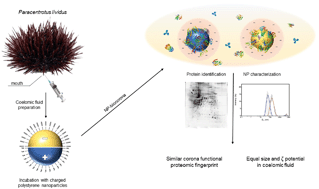Proteomic profile of the hard corona of charged polystyrene nanoparticles exposed to sea urchin Paracentrotus lividus coelomic fluid highlights potential drivers of toxicity†
Abstract
Polystyrene nanoparticles (PS NPs) are considered an upcoming threat to marine ecosystems. When NPs encounter biological fluids, they are readily covered by a biomolecular coating, named the “protein corona”, which critically drives the biological fate and toxicity of NPs. Here we provide the first attempt to identify key components of protein coronas of charged amino- and carboxyl-functionalized (PS-NH2 and PS-COOH, respectively) PS NPs exposed to coelomic fluid (CF) of the Mediterranean sea urchin Paracentrotus lividus. The formation of protein coronas conferred identical colloidal features to both positively and negatively charged PS NPs, which acquired a negative ζ potential and monodisperse size distribution in sea urchin CF. Proteomic analysis revealed striking functional analogies of proteins identified from NP–coronas, especially entailing the potential to promote cell association and internalization of both NP types, as mediated by adsorbed protein species. Such basal findings strengthen the importance of the biological identity of NPs in the evaluation of the ecotoxicity potential of polymeric NPs.



 Please wait while we load your content...
Please wait while we load your content...